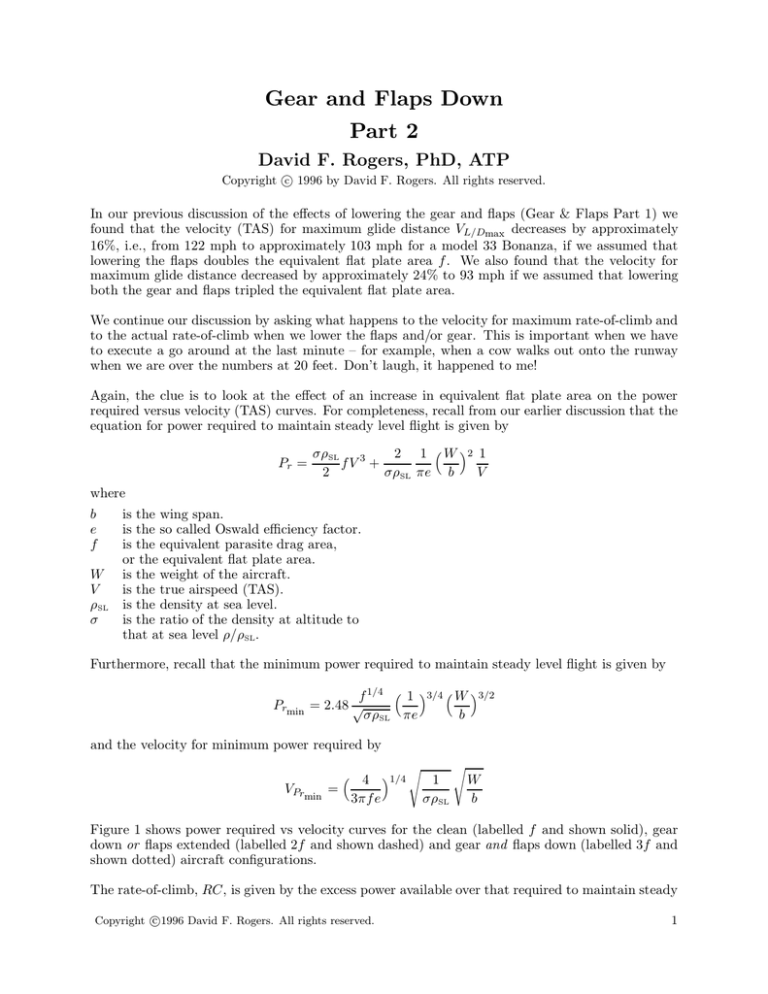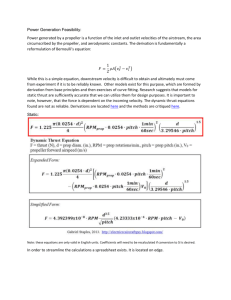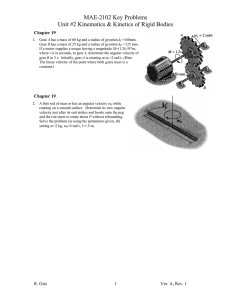
Gear and Flaps Down
Part 2
David F. Rogers, PhD, ATP
c 1996 by David F. Rogers. All rights reserved.
Copyright In our previous discussion of the effects of lowering the gear and flaps (Gear & Flaps Part 1) we
found that the velocity (TAS) for maximum glide distance VL/Dmax decreases by approximately
16%, i.e., from 122 mph to approximately 103 mph for a model 33 Bonanza, if we assumed that
lowering the flaps doubles the equivalent flat plate area f . We also found that the velocity for
maximum glide distance decreased by approximately 24% to 93 mph if we assumed that lowering
both the gear and flaps tripled the equivalent flat plate area.
We continue our discussion by asking what happens to the velocity for maximum rate-of-climb and
to the actual rate-of-climb when we lower the flaps and/or gear. This is important when we have
to execute a go around at the last minute – for example, when a cow walks out onto the runway
when we are over the numbers at 20 feet. Don’t laugh, it happened to me!
Again, the clue is to look at the effect of an increase in equivalent flat plate area on the power
required versus velocity (TAS) curves. For completeness, recall from our earlier discussion that the
equation for power required to maintain steady level flight is given by
Pr =
σρSL
2 1 W 2 1
fV 3 +
2
σρSL πe b
V
where
b
e
f
W
V
ρSL
σ
is the wing span.
is the so called Oswald efficiency factor.
is the equivalent parasite drag area,
or the equivalent flat plate area.
is the weight of the aircraft.
is the true airspeed (TAS).
is the density at sea level.
is the ratio of the density at altitude to
that at sea level ρ/ρSL.
Furthermore, recall that the minimum power required to maintain steady level flight is given by
f 1/4 1 3/4 W 3/2
Prmin = 2.48 √
σρSL πe
b
and the velocity for minimum power required by
VPrmin
4 1/4
=
3πf e
1
σρSL
W
b
Figure 1 shows power required vs velocity curves for the clean (labelled f and shown solid), gear
down or flaps extended (labelled 2f and shown dashed) and gear and flaps down (labelled 3f and
shown dotted) aircraft configurations.
The rate-of-climb, RC, is given by the excess power available over that required to maintain steady
c
Copyright 1996
David F. Rogers. All rights reserved.
1
350
E33A
W = 3300 lbs
Sea Level
300
3f
2f
f
Power (hp)
250
Thrust power
available
200
150
Power required
100
50
0
0
Figure 1.
50
100
150
Velocity (mph)
200
250
Thrust power available (constant) and power required versus velocity.
level flight divided by the weight of the aircraft. Expressed as an equation this is
rate-of-climb =
power available − power required
weight
The rate-of-climb equation is not quite as simple as it looks. The power available is in fact the
Thrust Power Available. The thrust power available is the power delivered by the engine and
propeller combination. A propeller is not 100% efficient in converting the power available at the
engine propeller shaft to thrust. Consequently, we must account for propeller efficiency. The thrust
power available, T hPa , is the engine power at the propeller shaft, Pa , multiplied by the propeller
efficiency, η (eta), i.e.,
T hPa = ηPa
Thus, our rate-of-climb equation is
T hPa − Pr
W
For a given propeller, at a given RPM, the efficiency of the propeller depends on the velocity
of the aircraft. However, as a first approximation we can consider the propeller efficiency to be
constant. At the low velocities associated with a go around, the propeller efficiency is quite low. A
good number is about 70% (see Fig. (2)). Therefore, to get an approximation to the thrust power
RC =
c
Copyright 1996
David F. Rogers. All rights reserved.
2
available for a model 33A we multiply 285 hp by 0.7. The result is 199.5 horsepower, that is, just
under 200 horsepower. This is shown as a dotted straight line in Fig. (1).
Looking at Fig. (1) and recalling our rate-of-climb eqauation shows that the maximum rate-ofclimb occurs for minimum power required at the velocity for minimum power required. Figure 1
also shows that the velocity for maximum rate-of-climb, given by the largest distance between the
thrust power available and power required curves, decreases when the equivalent flat plate area, f ,
increases, that is, when we lower the gear and/or flaps. Our velocity for minimum power required
equation then shows that the ratio of VRCmax dirty, i.e., with gear and/or flaps down, to that in
the clean configuration is
f
VRCmax (dirty)
clean 1/4
=
VRCmax (clean)
fdirty
Recall that lowering the gear or flaps approximately doubles the equivalent flat plate area, f . Thus,
with the gear down or the flaps extended
VRCmax (dirty)
VRCmax (clean)
0.9
1 1/4
2
= 0.84
E33A
McCauley 3-blade
Full throttle
2700 RPM
Sea Level
0.8
Propeller efficiency
=
0.7
0.6
0.5
0
Figure 2.
50
100
150
Velocity (mph)
200
250
Propeller efficiency versus velocity.
c
Copyright 1996
David F. Rogers. All rights reserved.
3
which shows that VRCmax (dirty) decreases by approximately 16% from the clean configuration.
Lowering the gear and extending the flaps to 30◦ approximately triples the equivalent flat plate
area, f . For this configuration
VRCmax (dirty)
VRCmax (clean)
=
1 1/4
3
= 0.76
which shows that VRCmax (dirty) decreases by approximately 24% from the clean configuration.
These are significant effects. Notice that these are exactly the same factors by which the best glide
velocity decreases when the gear and/or flaps are extended.
What these results tell us is that with gear down and flaps extended the aircraft must be flown at
the correct (lower) velocity to achieve the maximum rate-of-climb.
We now want to investigate the effect of flying the aircraft at the incorrect velocity for the maximum
rate-of-climb. To do this we need to more accurately consider the variation of propeller efficiency
with velocity. For a typical McCauley 80 inch diameter constant-speed three blade propeller, the
propeller efficiency, η, at full throttle and 2700 rpm at sea level is shown in Figure 2. Notice that
the efficiency is quite low at low velocities and reaches a maximum of about 88-90% for typical
cruise velocities. The effect of the variation of propeller efficiency with velocity on the curve of
thrust power available is shown as the dotted line in Fig. (3).
Recalling the rate-of-climb equation shows that taking the difference between the thrust power
available curve and the power required curves at a given velocity and dividing by the weight yields
the rate-of-climb at that velocity.
The rate-of-climb curves for the clean configuration (labelled f and shown solid), gear down or .
flaps extended (labelled 2f and shown dashed) and gear and flaps down (labelled 3f and shown
dotted) are given in Fig. (4). Zero rate-of-climb is indicated by the horizontal dotted line. Because
of the variation of propeller efficiency with velocity the velocity for maximum rate-of-climb is higher
than given by our earlier approximate results.
For example, with gear down and flaps extended our results indicate that maximum rate-of-climb
is approximately 810 fpm at approximately 89 mph. However, the POH (old version) gives the
velocity for best rate-of-climb gear and flaps down as 77 mph. Our results appear to be about
13% too high. The explanation is that our rate-of-climb equation does not account for the upward
inclination of the thrust produced by the propeller nor for the effect of the propeller slip stream
on the wing. The detailed analysis is too complex to go into here, but we can estimate the effects
of propeller thrust indirectly. For an E33A the POH (old version) gives the gross weight stalling
velocity gear and flaps down power off as 61 mph and power on as 46 mph.
The corresponding values for gear and flaps up are 72 mph and 57 mph. Thus, the effect of power is
to reduce the stalling velocity 20-25%. Because the velocities for maximum rate-of-climb are higher
than the stall velocities, the effect of power is decreased by about 50%. Using a 13% reduction in
the calculated velocity for maximum rate-of-climb yields the value given in the POH. Incidentally
77 mph is the experimental value for 4000 feet published by Taylor and Guinther in Positive Flying,
+
a book that I recommend.
What is most important from all this discussion is to note that flying at either too slow or too
high a velocity degrades the climb performance. Also, note that maximum rate-of-climb occurs
+ Richard L. Taylor and William M. Guinther, Positive Flying, MacMillan, New York, 1978.
c
Copyright 1996
David F. Rogers. All rights reserved.
4
350
E33A
W = 3300 lbs
Sea Level
300
3f
2f
f
r
we
o
tp
us
r
Th
200
lab
le
Maximum
velocity
ed
150
i
ava
ir
Power (hp)
250
100
Po
we
e
rr
qu
50
0
0
Figure 3.
50
100
150
Velocity (mph)
200
250
Power available (variable) and power required versus velocity.
for a significantly lower velocity with the gear and flaps extended than in the clean configuration.
Finally, a word of caution. In order to simplify the discussion I make assumptions, for example
above I neglected the effects of thrust inclination on the rate-of-climb. Consequently, the numbers
that result are not always exact. Thus, you should follow the procedures in the POH; after all,
Beech has more complete data. The principles are the most important result.
For operational considerations, note that as we clean up the aircraft by retracting the gear and flaps
we need to allow the aircraft to accelerate to a higher velocity to achieve maximum rate-of-climb.
Because flap retraction speed is generally slower than gear retraction speed for a model 33, and
opening the inner gear doors to retract the gear increases the drag, these results indicate that we
should retract the flaps first and then the gear as we clean up the aircraft and allow it to accelerate
and simultaneously adjust the pitch to maintain the velocity for maximum rate-of-climb.
Fortunately, for those of us who fly with the 285 hp engine there is a wide range of velocities that
result in a positive rate-of-climb in the dirty configuration at sea level. However, as the density
altitude increases the rate-of-climb versus velocity curves (in terms of indicated airspeed) essentially
move downward. The result is a narrowing of the range of velocities that achieve a positive rateof-climb. Furthermore, there is an altitude above which the aircraft will not climb in the dirty
c
Copyright 1996
David F. Rogers. All rights reserved.
5
1500
E33A
W = 3300 lbs
Sea Level
1000
Rate-of-climb (fpm)
500
0
-500
-1000
3f
2f
f
-1500
0
Figure 4.
50
100
150
Velocity (mph)
200
250
Rate-of-climb versus velocity.
configuration. Thus, precise speed control and attention to cleaning up the aircraft become more
important. We’ll look at density altitude effects in Altitude Effects, Part 1.
c
Copyright 1996
David F. Rogers. All rights reserved.
6



